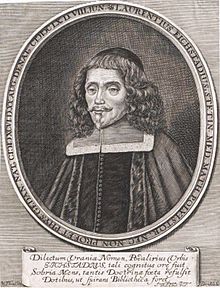Lorenz Eichstaedt
Lorenz Eichstaedt (born August 10, 1596 in Stettin , † June 8, 1660 in Danzig ) was a German physician , astronomer and calendar maker .
Life
Eichstaedt was the son of the Stettin merchant Peter Eichstaedt and his wife Anna, daughter of the Council Chamberlain Peter Mathias in Gollnow in Pomerania . After attending the education department in Stettin , he studied in Greifswald in 1612/1613 , then from 1614 in Wittenberg with Daniel Sennert . From 1617 to 1619 he studied at various universities in Germany and Holland, then practiced from 1619 with the doctor David Faber in Altenburg. In 1621 he received his doctorate in Wittenberg and then settled as a doctor in Stargard in Pomerania .
In 1624 - only 24 years old - he became a city physician in Stettin. In 1628 he married Katharina Giese, the daughter of the Szczecin Mayor Paul Giese . From this marriage there were six children, four sons and two daughters. In the years 1625, 1630 and 1638 Eichstaedt was particularly challenged by the plague that raged in Stettin . In 1633 and 1640 he traveled to Holland to maintain his scientific contacts there.
After more than 20 years of work in Stettin, he was appointed to Gdansk in 1645 as a city physician and professor of medicine, mathematics and physics at the Academic Gymnasium , where he worked until the end of his life. In Danzig he met the then still young and unknown astronomer Johannes Hevelius , for whose Selenographia, published in 1647, he wrote a praise poem in Latin hexameters , which was printed with the work.
Eichstaedt had already written an astronomical work in Stargard on a conjunction of the planets Jupiter and Saturn , which was published in Stettin in 1622. In the following years other works appeared, both medical and astronomical subjects, the most important of which were the ephemeris , published between 1634 and 1644 . These were tables in which the predicted positions of the planets were recorded for the use of geographers, navigators and astronomers. They continued the famous Rudolfinian tablets created by Johannes Kepler and published in 1627 .
From 1615 he published his astronomical results in calendars, which he enriched with detailed descriptions of his observations and calculations.
He was buried on June 14, 1660 in the Danzig Trinitatiskirche .
The lunar crater Eichstadt is named after him.
Fonts
- Disputationum de Corpore mixto . Wittenberg 1615.
- Prognosticon de Coniunctione Magna Saturni et Jovis in Trigono Igneo Leonis . Szczecin 1622.
- De Confectione Alchermes . Stettin 1634. ( digitized version )
- Ephemerides . Stettin 1634 and 1636, Danzig 1644.
- Paedia Astrologica . Szczecin 1636.
- Tabulae Harmoniae Coelestium . Stettin 1644. ( digitized version )
- Collegium anatomicum . Danzig 1649.
- Planorum Geometria . Lübeck 1650.
- De Camphora to Hippocrati et aliis . Danzig 1650.
- Problemata electro-logica, physico-medica . Danzig 1650.
- Collegium physicum . Danzig 1654-1658.
literature
- Hans-Jürgen Kämpfert: Danzig natural scientist. In: Bernhart Jähnig , Peter Letkemann (Ed.): Danzig in eight centuries. Münster 1985.
- Christian Krollmann (Ed.): Old Prussian Biography. Vol. 1. 1941.
- Walther Schönfeld : Lorenz Eichstädt, former city physicist of Stettin and Danzig, professor of mathematics and physics, astrologer and calendar writer . In: Monthly sheets of the society for Pomeranian history and antiquity . Volume 53, 1939, pp. 169-173.
- Lynn Thorndike : History of Magic and Experimental Science . Vol. 7: The Seventeenth Century . Columbia University Press, New York 1958, pp. 146f.
- Dorothea Weichbrodt: patrician, citizen, inhabitant of the Free and Hanseatic City of Danzig . Danziger Verlagsgesellschaft Rosenberg, Klausdorf / Schwentine 1986.
- Eckhard Wendt: Stettiner Lebensbilder (= publications of the Historical Commission for Pomerania . Series V, Volume 40). Böhlau, Cologne / Weimar / Vienna 2004, ISBN 3-412-09404-8 , pp. 145–147.
Individual evidence
- ↑ Lorenz Eichstaet in the Bibliographisches Handbuch der Kalendermacher, accessed on June 17, 2016
Web links
- Works by and about Lorenz Eichstaedt in the German Digital Library
- Eichstaedt, Lorenz . In: East German Biography (Kulturportal West-Ost)
| personal data | |
|---|---|
| SURNAME | Eichstaedt, Lorenz |
| ALTERNATIVE NAMES | Eichstadt, Lorenz; Eichstadius, Laurentius; Eichstaedt, Laurentius; Eichstädt, Lorenz; Eichstadius, Lorenz |
| BRIEF DESCRIPTION | German medic and astronomer |
| DATE OF BIRTH | August 10, 1596 |
| PLACE OF BIRTH | Szczecin |
| DATE OF DEATH | June 8, 1660 |
| Place of death | Danzig |
